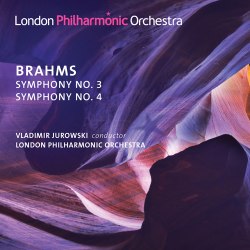|

|
Johannes BRAHMS (1833-1897)
Symphony No 3 in F major, Op. 90 [35:52]
Symphony No 4 in E minor, Op. 98* [39:43]
London Philharmonic Orchestra/Vladimir Jurowski
rec. live, 27 October 2010, *28 May 2011, Royal Festival Hall, London, DDD
LONDON PHILHARMONIC ORCHESTRA LPO-0075 [76:22]
I’m not sure I see the commercial logic behind this release except that it does complete a Jurowski Brahms cycle on CD - Symphonies 1 and 2 were released on LPO-0043. There are so many recordings of both symphonies in the catalogue already that this newcomer will have to offer something pretty special if it is to appeal to a wider audience than the followers of Vladimir Jurowski.
His reading of the Third Symphony gets off to a good, surging start and the calmer passages of music are also done well. The exposition repeat is taken. Mostly, I enjoyed this movement though one short agitated section (11:23 - 11:54) seemed a bit too fiercely projected. There’s a pleasing open-air feeling to the start of the second movement; the music sounds genial and is nicely paced. However, when the darker second theme arrives (2:07), and in the lead-up to that moment, I think Jurowski lingers a little too much, as he does whenever that material is revisited. It must be admitted, however, that the expressiveness for which he’s clearly striving in that section is achieved.
I like his way with the Poco allegretto, which is relaxed and unforced. Discussing the opening of the finale Lindsay Kemp’s notes refer to a ‘sudden, openly belligerent response from the full orchestra’ (at 0:51). I must say I’d never thought of the passage in question like that but, actually, it fairly describes the effect that Jurowski achieves here. There’s much exciting, fiery playing during the opening few minutes of this movement but too often it sounded to me as if the music was being over-driven. The LPO’s violas make a lovely sound at 6:04, ushering in the wonderful, warm wind-down to the end; this section is well done by Jurowski. So, his Brahms Third is something of a swings-and-roundabouts performance but, on balance it has more positives than negatives.
In the taut first movement of the Fourth his reading is, for the most part, sensibly paced and it evinces a good sense of purpose. My main reservation is that, for expressive effect, he lingers a little on occasion during the development. Each time I’ve listened to this performance the start of the Andante moderato sounds too slow; the music seems to lack sufficient momentum. Yet, as the movement unfolds I’ve come to feel more comfortable with the pacing and overall I enjoyed this movement.
The notes refer to ‘terse energy and ebullience’ in the music of the third movement. I certainly get the former in this performance but I’m not at all sure about the latter. Jurowski takes the music very quickly and to my ears the result sounds fierce and driven rather than giocoso. To be honest, I think this might sound superficially exciting in the concert hall but I’m unsure how suitable this interpretation is for repeated listening.
The great passacaglia is darkly dramatic at first. The desolate flute-led variation is rather drawn-out, I feel (3:08 - 3:53). When the full orchestra resumes the argument (from 5:39) the music sounds biting and very dramatic but my initial reaction, which hasn’t changed on repeated listening, is that from this point to the end of the movement Jurowski overplays his hand at times and allows the music to sound too vehement and even aggressive. The performance is greeted rapturously by the audience but I’m not sure it’s how Brahms meant this movement to sound.
Out of curiosity and to see if I’d over-reacted to the last two movements I played them in another version. This is the recently released recording, made in 2011, by Stanislaw Skrowaczewski for Oehms (OC 410). Skrowaczewski was 87 at the time he made this recording and with a lifetime’s experience of Brahms conducting behind him. My goodness, it shows. In the third movement he’s nowhere near as hectic as Jurowski - he takes 6:07 against Jurowski’s 5:40 - yet there’s no lack of energy: the energy comes from within, one feels, and is not imposed. There’s much more light and shade in the playing too, though it must be acknowledged that we are comparing a studio recording with a live performance. Turn to the finale and the contrasts are equally strong and equally in favour of the senior conductor. Again the pacing is steadier but what catches the attention is Skrowaczewski’s acute ear for and understanding of Brahmsian textures. As a result, once again, one finds far more light and shade in his version as compared to Jurowski’s - for whom, by the way, the LPO plays well. In the second half of the movement Skrowaczewski’s reading has ample power but everything is well controlled and the degree of power is never overdone.
I mention this comparison to suggest that there is more to this great symphony than Jurowski finds in it: I wonder how long it has been in his repertoire.
Both performances are presented in good sound and the LPO plays well for its principal conductor. There is loud applause after the Fourth Symphony but, curiously, none at all after the Third. In the last analysis I don’t think that either of these performances - and certainly not the performance of the Fourth - is really a match for the best in a very crowded catalogue. Both concerts were reviewed for Seen and Heard by Mark Berry. You can read his review of the Third Symphony here and his review of the Fourth here.
John Quinn
Masterwork Index: Symphony 3 ~ Symphony 4
 |
 |
|
